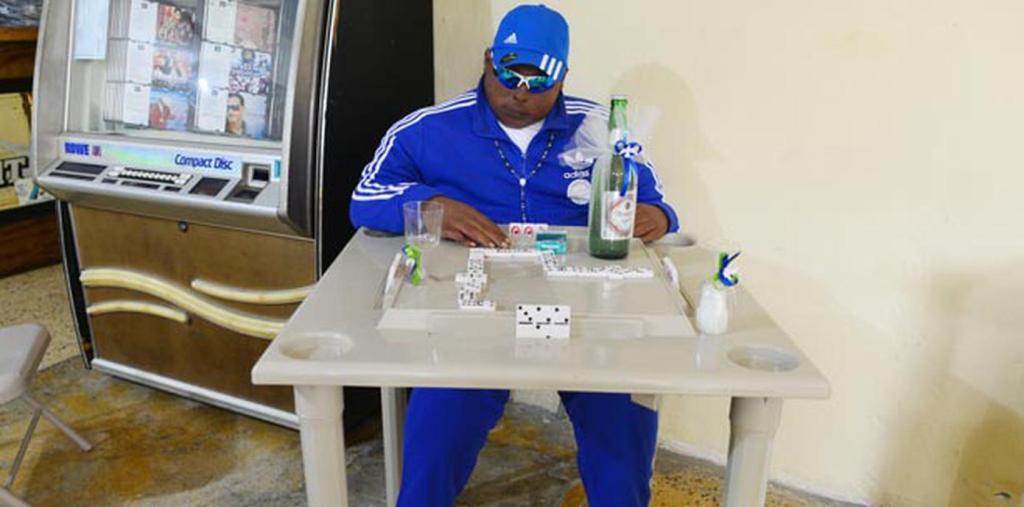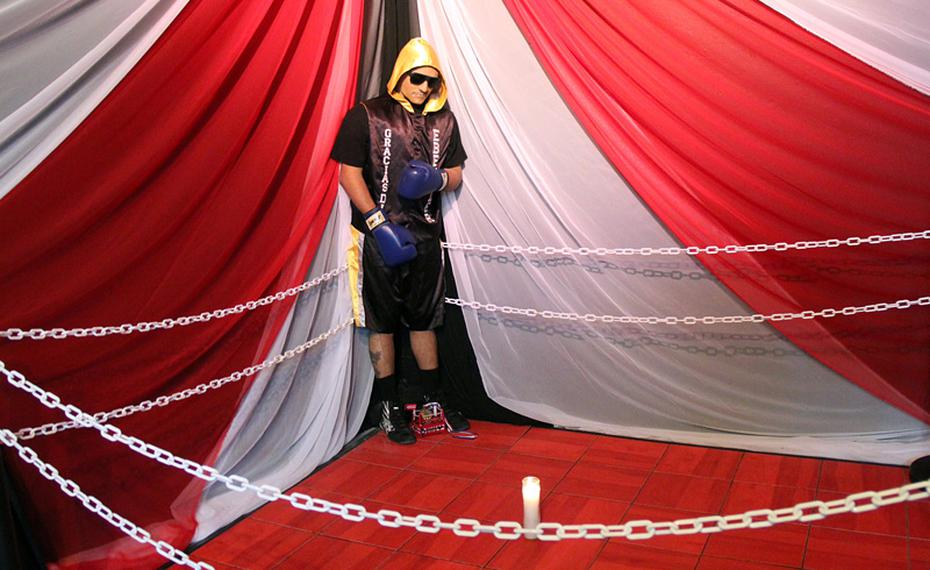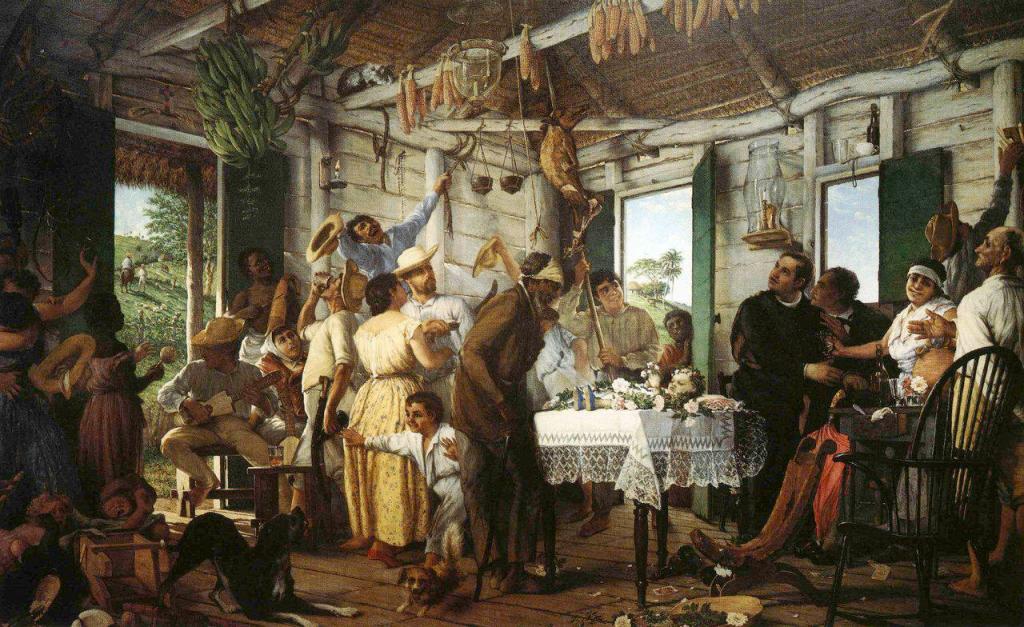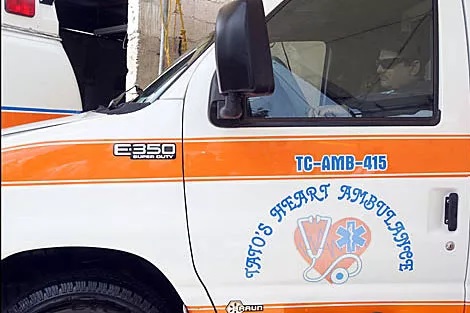It seemed like a regular day at Tato’s Heart Ambulance in July of 2010. Edgardo Velázquez Velázquez was in the driver’s seat of one of the fleet’s vehicles. Velázquez Velázquez seemed ready to go, but he would not be driving off the company premises. He would actually be interred at the end of the day. You see, he had been killed by his best friend in an alleged accident involving guns. Prior to his passing, he had mentioned that he wanted to be embalmed and viewed in one of the ambulances. Being a beloved figure in the community, the family honored his wishes and held his funeral at his ambulance company, making it the fourth instance of extreme embalming in Puerto Rico.
Velázquez Velázquez’s velorio exótico, or exotic wake, is predated by at least three more instances of extreme embalming, which is a form of dynamic body preservation wherein the body purposely avoids the illusion of rest. Instead of preparing the body in the conventional resting pose, corpses are preserved in such a way that they are presented as standing, sitting, and even riding. Or, in Velázquez Velázquez’s case, driving an ambulance. While now there are instances of these wakes in other Caribbean islands and the United States, the practice can be traced back to Puerto Rico. Starting in 2008 with el muerto parao, or the standing corpse, it was the first body that was embalmed in a non-resting pose and viewed without a coffin. Ángel Luis “Pedrito” Pantojas Medina was murdered, and in a final act of resistance, he asked to be embalmed standing up, wearing his favorite clothes. Not only that, but his wake was held in his home, an apartment at the Juan César Cordero public housing project. Media outlets such as Primera Hora surmised that his unique request was a way of sending a message to his enemies, that he was standing to the end, “once tiros, pero de pie:” eleven gunshots, but still standing. Pantojas Medina’s funeral went on to inspire a number of velorios insólitos throughout the years such as Velázquez Velázquez’s, as well as other people of all ages, even pets.

These extreme embalming instances have grown more complex with each wake. While Pantojas Medina asked to be viewed standing up, in a corner of the room, his eyes were still closed and there were no additional items beyond his garments. Future wakes would usually involve props ranging from small items that were put into the deceased’s hands to entire vehicles and staging. There even was an instance in which the deceased had their eyes open. For example, two years after Pantojas Medina’s funeral, David N. Morales Colón passed away and was embalmed on top of his motorcycle, which was brought into Marín Funeral Home for viewing. Velázquez Velázquez’s ambulance viewing at his own business was held in the same year. Later wakes involving extreme embalming were more intricate: Carlos M. Cabrera Mercado was dressed like Che Guevara, embalmed in a sitting position, and presented in the community’s basketball court. Christoper Rivera, a Puerto Rican boxer, was prepared as if he were ready for a boxing match, ring included. Then we have Jomar Aguayo Collazo, who was embalmed in a sitting position and placed in his mother’s bar, Bar Carmín, wherein he spent the day listening to his favorite music, having beers, and playing dominoes with his friends for one last time.

Yet, what motivated these individuals to forgo more traditional funerary practices in favor of extreme embalming? It is more than simply bucking convention; it is a way of preserving identity up to the very last moment. These unique velorios afford the deceased a chance to face death on their own terms: most of the instances of extreme embalming were advance directives established by the deceased either in conversation or in direct planning with the funeral home. Likewise, it allows friends and family to recall their loved ones in a way that is representative of how they lived their lives. As Luis Cintrón Gutiérrez notes, funerary rites, including the wake, dramatize societal attitudes and lifestyles. Meaning, our deaths mirror our lives. This has not necessarily been the case for many years: after all, the “at rest” approach has been adopted as the de facto presentation of the dead. Velorios exóticos do away with the coffin and the illusion of sleep. They present the dead as active participants of life, doing things that they love, and in such a way that one can simply walk up to them and interact. As Laura Panizo elaborates, the wake is a juncture that is full of details and symbols that project the deceased individual as the protagonist. In that moment, the corpse assumes a performance role that forces death’s coexistence with family and life until the time of burial.

Cintrón Gutiérrez notes that, in death, the corpse becomes a communicative instance: the wake is the last chance to be a part of the conversation and manifest who they were in life. It is the individual’s last moment in the community, which is an important part of Puerto Rican funerary rites dating back to ancestral indigenous burials and baquiné practices. The Taíno people believed that the deceased were part of the community, which led to partial or total body preservation and the creation of cemí, which are carved triangular stones that are imbued with ancestral or godly spirits. Additionally, even if there was physical decay, the deceased never left: they became community protectors that watched out for future generations, albeit from the spiritual realm. All of this changed with Spanish colonization; suddenly, cemí were no longer allowed, bodies had to be buried in a “Christian burial,” and the concepts of heaven and hell were introduced. Likewise, when enslaved Africans came to Puerto Rico, they came with their own funerary practices, which were also restricted by colonial rule. These imposed funerary rites had to be assumed; otherwise, they risked fines and social rejection. However, mortuary resistance was still happening: people living in rural areas were able to skirt Spanish mandates, and practices such as the baquiné, or the funeral de angelito, and natural burial kept occurring. Immortalized by Francisco Oller in his painting El velorio, the baquiné is a home funeral, typically associated with the death of a child, that is more of a celebration than a mourning. Food and drink abound, as well as music, because the family is celebrating that heaven has another angel. Colonial rule and higher echelons of society were horrified by this practice, but it gained traction in the civilian community, surviving to this day (although the practice has diminished). Thus, the baquiné is an act of resistance that involves community, which is reminiscent of modern velorio exotico practices: we are celebrating the dead, not grieving in the traditional, colonial, Christian sense.

Much like Taíno and African funerary practices, as well as baquinés, extreme embalming had quite a response when it first occurred. While many communities embraced it, at an administrative and political level, there were negative comments and indications that the legality of the proceedings would be investigated. Since the practice is legal, the government has not intervened, despite some officials expressing discomfort. However, some churches in Puerto Rico and across the Caribbean have banned exotic wakes, so they must be carried out in the funeral parlor or in the individual’s own home. While the pandemic paused extreme embalming for a while, it came back as soon as November 2020, in Trinidad and Tobago. In November 2021, the “muerto en four track”, occurred in Puerto Rico. Likewise, it is now practiced in the United States, usually by members of the Caribbean Diaspora and Black communities. An early example of this is Miriam “Mae Mae” Burbank’s funeral in 2014. A huge fan of the New Orleans Saints, she was dressed in the team colors, down to her nails. As Yahoo reported, Burbank was sitting at a table, as if greeting guests, “posed with a beer, a menthol cigarette, and an ashtray at a table.” How was Burbank’s unique request perceived by her family and friends? Her sister Sherline stated:
“When I walked in, I feel like I was in her house and I didn’t hurt so much…Because it’s more of her, and it’s like she’s not dead. It’s not like a funeral home. It’s like she’s just in the room with us.”
Sherline’s feelings are shared by many loved ones that have participated in exotic wakes. They touch the loved one, holding hands, kissing, or hugging. They “play” domino with them and spend their last moments reminiscing. Extreme embalming subverts the traditional idea of a “good death:” it is no longer a passive or submissive instance. It is an active exchange between the living and the deceased that reinstates the idea that death is communal, not solitary. It gives family and friends a way to honor their loved ones via their last wishes. So, despite religious protests and sensationalized coverage, exotic wakes continue.
Stella M. Ramírez Rodríguez earned her Master of Arts in English Education in the Department of English at the University of Puerto Rico, Mayagüez Campus. She is currently pursuing her doctorate in Caribbean Literature at the University of Puerto Rico, Río Piedras Campus. Her academic work explores the supernatural, folklore, and necropolitics within Boricua and Latino communities. Outside of academia, she can be found working within the animal welfare community as a humane educator, volunteer, and coordinator. You can find out more about her work on Twitter and Instagram @chromachord
Image credits
- Edgardo Velázquez Velázquez, “El muerto en la ambulancia.” Marín Funeral Home. https://marinfuneralhomepr.com/el-muerto-en-ambulancia/
- “El muerto parao.” Alicea Marcado, Juan.“The body of Angel Pantoja Medina.” El Nuevo Dia/AP/The Washington Post. https://www.washingtonpost.com/news/morning-mix/wp/2014/05/27/a-funeral-homes-specialty-dioramas-of-the-propped-up-dead/
- Alcalá del Olmo, Luis. Primera Hora. https://www.primerahora.com/noticias/puerto-rico/notas/lo-velan-jugando-domino-dentro-de-un-bar-en-rio-piedras/#view
- Figueroa, Alex. “Christopher Rivera.” Primera Hora. https://www.primerahora.com/deportes/boxeo/notas/velan-a-boxeador-asesinado-de-pie-y-en-uniforme/
- Oller, Francisco. El velorio. https://reggaetonpuertorico.wordpress.com/2015/03/08/pintura-de-francisco-oller-el-velorio/
References
Cintrón Gutiérrez Luis Javier. “Entre “hacer historia” y “¡Qué me velen para’o!”: velorios exóticos y marginalidad contemporánea en San Juan de Puerto Rico.” Cuadernos Inter.c.a.mbio sobre Centroamérica y el Caribe, vol. 16, no. 1, 2019, pp. 41-64.
Panizo, Laura. (2012). Cuerpo, velatorio y performance. TÁN@TO’S: Revista de la Sociedad Española e Internacional de Tanatología, 13, 24-35.
Primera Hora. “Cumplen deseo de que lo velen de pie” [Puerto Rico]. Primera Hora, 22 Jan. 2020, http://www.primerahora.com/noticias/puerto-rico/notas/cumplen-deseo-de-que-lo-velen-de-pie.
Solé, Elise. “Body of Dead Teen, Honored with ‘Extreme Embalming,’ Is Posed with Video Games, Sunglasses, and Snacks.” Yahoo Sports, 9 July 2018, ca.sports.yahoo.com/news/body-dead-teen-honored-extreme-embalming-posed-video-games-sunglasses-snacks-182105773.html
